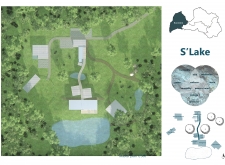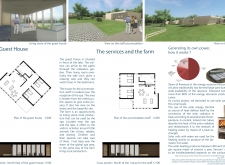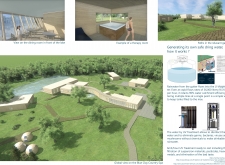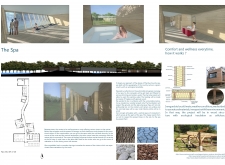5 key facts about this project
The primary function of the S’Lake project revolves around providing a holistic wellness experience. It includes spaces dedicated to relaxation, therapy, and reflection, all aimed at enhancing physical and mental health. Designed as a retreat, the spatial organization allows for individual and communal activities, emphasizing the importance of personal wellness within a serene context. The architecture facilitates a variety of therapeutic programs, from spa treatments to natural landscapes that invite outdoor exploration.
Central to the design is the guest house, which features expansive windows that invite natural light and offer breathtaking views of the adjacent lake. This openness fosters a sense of tranquility and encourages occupants to engage fully with the natural surroundings. The integration of spa facilities enhances the user experience by situating therapy rooms and relaxation areas within sight of nature, offering both visual and auditory connections to the outdoors.
The project utilizes materials that resonate with its environment, reinforcing the principles of sustainability and ecological integrity. Notably, timber serves as a primary material for both structural elements and exterior cladding. This choice not only contributes to the warmth and aesthetic appeal of the spaces but also aligns with environmentally conscious construction practices. Large glass panels are strategically placed throughout the design to maximize daylight while maintaining an unobtrusive connection to the serene landscape. Additionally, the use of stone pavers enhances the continuity of outdoor pathways, reflecting the organic contours of the site.
A unique aspect of S’Lake lies in its self-sustainable energy systems, which comprise solar panels and rainwater harvesting solutions designed to meet the facility's energy needs while reducing its environmental footprint. This innovative approach demonstrates a commitment to responsible architecture and sets an example for future projects in terms of ecological design. The incorporation of a native garden not only serves aesthetic purposes but also engages visitors in an interactive experience with local flora and fauna, fostering a deeper appreciation for the local ecosystem.
The architectural design emphasizes a fluid relationship between indoor and outdoor spaces, encouraging a lifestyle that embraces nature. Curvilinear pathways wind through carefully curated gardens, facilitating movement while enhancing the natural beauty of the site. This thoughtful layout allows guests to wander freely, promoting exploration and connection with the landscape, while also ensuring clear accessibility to various functional areas.
S’Lake stands as a testament to the potential of architecture to enhance human well-being through thoughtful design and sustainability. By intertwining the elements of nature, functionality, and innovative construction methods, this project exemplifies how modern architecture can contribute to personal health and ecological responsibility. To gain deeper insights into the architectural ideas and the spatial organization of this project, readers are encouraged to explore the accompanying presentation, particularly focusing on the architectural plans, sections, and designs that illustrate the meticulous thought and creativity invested in this unique endeavor.


























